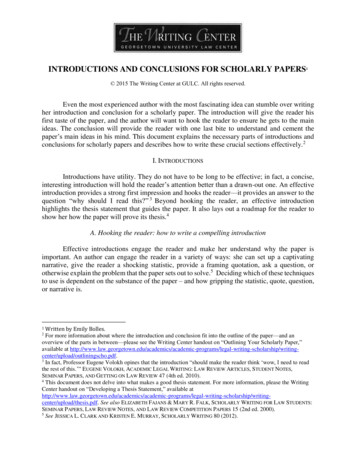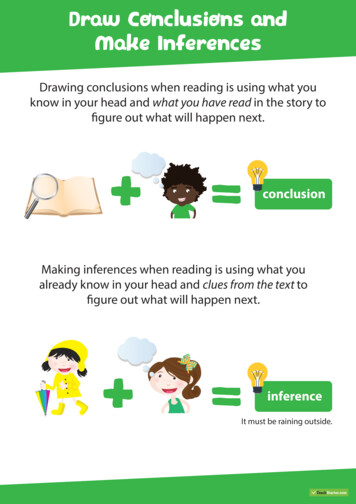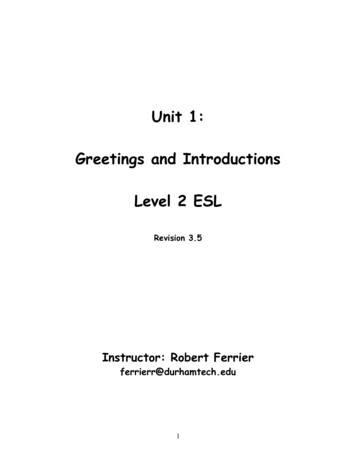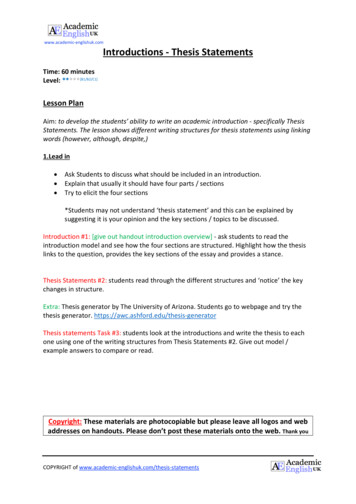
Transcription
INTRODUCTIONS AND CONCLUSIONS FOR SCHOLARLY PAPERS1 2015 The Writing Center at GULC. All rights reserved.Even the most experienced author with the most fascinating idea can stumble over writingher introduction and conclusion for a scholarly paper. The introduction will give the reader hisfirst taste of the paper, and the author will want to hook the reader to ensure he gets to the mainideas. The conclusion will provide the reader with one last bite to understand and cement thepaper’s main ideas in his mind. This document explains the necessary parts of introductions andconclusions for scholarly papers and describes how to write these crucial sections effectively.2I. INTRODUCTIONSIntroductions have utility. They do not have to be long to be effective; in fact, a concise,interesting introduction will hold the reader’s attention better than a drawn-out one. An effectiveintroduction provides a strong first impression and hooks the reader—it provides an answer to thequestion “why should I read this?” 3 Beyond hooking the reader, an effective introductionhighlights the thesis statement that guides the paper. It also lays out a roadmap for the reader toshow her how the paper will prove its thesis.4A. Hooking the reader: how to write a compelling introductionEffective introductions engage the reader and make her understand why the paper isimportant. An author can engage the reader in a variety of ways: she can set up a captivatingnarrative, give the reader a shocking statistic, provide a framing quotation, ask a question, orotherwise explain the problem that the paper sets out to solve.5 Deciding which of these techniquesto use is dependent on the substance of the paper – and how gripping the statistic, quote, question,or narrative is.Written by Emily Bolles.For more information about where the introduction and conclusion fit into the outline of the paper—and anoverview of the parts in between—please see the Writing Center handout on “Outlining Your Scholarly Paper,”available at load/outliningscho.pdf.3In fact, Professor Eugene Volokh opines that the introduction “should make the reader think ‘wow, I need to readthe rest of this.’” EUGENE VOLOKH, ACADEMIC LEGAL WRITING: LAW REVIEW ARTICLES, STUDENT NOTES,SEMINAR PAPERS, AND GETTING ON LAW REVIEW 47 (4th ed. 2010).4This document does not delve into what makes a good thesis statement. For more information, please the WritingCenter handout on “Developing a Thesis Statement,” available upload/thesis.pdf. See also ELIZABETH FAJANS & MARY R. FALK, SCHOLARLY WRITING FOR LAW STUDENTS:SEMINAR PAPERS, LAW REVIEW NOTES, AND LAW REVIEW COMPETITION PAPERS 15 (2nd ed. 2000).5See JESSICA L. CLARK AND KRISTEN E. MURRAY, SCHOLARLY WRITING 80 (2012).12
For example, let’s pretend you are writing a paper condemning the Supreme Court’sdecision in Citizens United. Here are a few options for your introduction: “A corporation is an artificial being, invisible, intangible, and existing only incontemplation of law . . . it possesses only those properties which the charter of its creationconfers upon it, either expressly or as incidental to its very existence.” This is JohnMarshall’s definition of a corporation in Dartmouth College v. Woodward.6Seventy-eight percent of 2012 outside election spending can be attributed to the 2010Citizens United ruling.7What do you think of when you hear the word “person”? Some say “human” and evokequalities like free will and rational thinking. Others think of breath—or a heartbeat.Citizens United was decided on January 21st, 2010.Just based on these sentences, which paper would you like to read? Chances are, it’s not the lastone—the date Citizens United was decided is not particularly interesting. Avoid factual recitation;instead, an introduction should be creative and motivate the reader to keep going. Choosingbetween the rest of these potential lead-ins is likely dependent on your thesis and what you wantto accentuate at the beginning of your paper.You may also want to consider using a narrative introduction for your Citizens Unitedpaper. Narrative introductions are common in scholarly writing, and can be incredibly effective.A narrative introduction tells a short story for the reader that illustrates the problem the paper setsout to solve. Effective narrative introductions are above all vivid.8 You might open your CitizensUnited paper with a story about a headline-grabbing attack-ad crossfire between Mitt Romney andNewt Gingrich, 9 a portrayal of the current state of presidential elections, 10 or a narrativedescription of a hypothetical,11 or any other compelling narrative you find in your research.B. Connecting to the thesis statementAn effective introduction highlights and gives depth to the thesis statement. Practically,that means that the introduction must set the stage for the thesis statement to make sense to thereader and that the introduction must state the thesis!12Trustees of Dartmouth Coll. v. Woodward, 17 U.S. 518, 636 (1819). For examples of law review articles that openwith a quote, see Colin Cox, Protecting Free Speech After Citizens United: Why Overruling Austin v. MichiganChamber of Commerce Violates the First Amendment and Encourages Corruption in Campaigns, 55 S. TEX. L. REV.339 (2013); Molly J. Walker Wilson, Too Much of A Good Thing: Campaign Speech After Citizens United, 31CARDOZO L. REV. 2365 (2010).778% of Outside Campaign Spending Due to ‘Citizens United Effect’, COMMON effect (lastvisited Feb. 1, 2015).8See VOLOKH, supra note 3, at 52.9See Leslie A. Gordon, Citizens Dis-United Justices May Take Another Look at Controversial Campaign FinanceCase, ABA J., May 2012, at 20.10James A. Kahl, Citizens United, Super Pacs, and Corporate Spending on Political Campaigns: How Did We GetHere and Where Are We Going?, FED. LAW., June 2012, at 40.11 Citizens United at Work: How the Landmark Decision Legalized Political Coercion in the Workplace, 128 HARV.L. REV. 669 (2014).12CLARK & MURRAY, supra note 2.62
Let’s pretend that the thesis statement of your paper is “Under an original intent reading ofthe Constitution, the Citizens United decision should be overturned because it went against ourfounding principles and was blatant judicial overreach.” The John Marshall quote listed above mayserve your paper well as an introduction because it harkens back to earlier meanings of the word“corporation” and thus implicates originalism. Conversely, the seventy-eight percent statisticwould not be an effective introduction because it is not tied to your thesis—even though it is relatedto Citizens United, the topic of your paper.C. Roadmapping the paperFinally, an effective introduction will include a roadmap for the paper. Roadmaps previewthe large scale organization for your reader and lay out how your analysis will proceed. Generally,the roadmap is the last paragraph in your introduction. The roadmap should lay out all the parts ofyour paper, but remember: the idea is that your reader will be able to expect and understand yourlarge-scale organization. Though effective roadmap paragraphs in different papers may differ intheir length and complexity, all effective roadmaps accurately represent the organization of thepaper and clearly tell the reader what that organization is.Let’s say your Citizens United paper is split into four parts, with these headings: I.Introduction; II. Original Intent and the Failings of Judicial Activism; III. Corporate Definition:Case Law Before Citizens United; IV. Getting it Wrong: Citizens United as Judicial Activism; V.Conclusion.Given those headings, a hypothetical roadmap for your Citizens United paper may looklike this:Part II discusses original intent as a Constitutional theory and explains thefailings of judicial activism in creating coherent jurisprudence. Part III describescase law leading up to Citizens United, showing that “personhood” did not includecorporations in the early years of the American government. Part IV applies atheory of original intent to Citizens United and argues that the case was wronglydecided and should be overturned.Through this roadmap, your reader will understand how your paper is organized, and theorganization will make logical sense to the reader because it revolves around the backgroundinformation and new analysis that is necessary to support your conclusion. Recap: IntroductionsIs the entire introduction concise and short enough to hold the reader’s attention?Are the first few sentences interesting?Does the introduction provide context for the thesis statement?Does the introduction clearly state the thesis?Does the introduction provide a roadmap paragraph?Does the roadmap paragraph accurately reflect the large scale organization of the paper?3
II. CONCLUSIONSThough they sometimes get short shrift in legal writing texts,13 conclusions are a crucialpart of any scholarly paper. Conclusions wrap up the paper and are the last opportunity for theauthor to make an impression on the reader. Effective conclusions reiterate the problem the thesisset out to solve, remind the reader what the thesis of the paper is and why it’s correct, and—bestof all—are short and to the point. 14To reiterate the problem that motivates the paper, it is effective to harken back to theintroduction. Invoking the introduction in the conclusion has the added benefit of tying the papertogether nicely and providing the reader with a sense of closure. For example, in your CitizensUnited paper, if you started off with a John Marshall quote, your conclusion might start with thesentences: “The Framers and respected judges in the early years of the American government neverwould have granted corporations personhood. Instead, as indicated by John Marshall, the foundinggeneration considered corporations as artificial legal constructs without rights other than thosevital to their existence.”Effective conclusions also remind the reader of your thesis and show her why your thesisis right. The conclusion can loosely follow the organization of your paper to parallel your roadmapgiven in the introduction, but the focus should be on the paper’s analysis rather than on theorganization. For example, your Citizens United paper would likely condemn judicial activism,reiterate the holding of Citizens United in your words, and remind the reader that you think thecase should be overturned. Importantly, effective conclusions do not bring in new information oranalysis; instead, they sum up what is already contained in the paper.1314See VOLOKH, supra note 3, at 76–78.CLARK & MURRAY, supra note 2, at 86–87.4
When putting together your conclusion, remember: effective conclusions are respectful ofthe reader’s time and do not drag on. They are often only one to two paragraphs.15 Recap: ConclusionsDoes the conclusion remind the reader of the problem the paper sets out to solve?Does the conclusion incorporate aspects of the introduction to give the reader closure?Does the conclusion’s organization parallel the paper’s organization?Does the conclusion re-state the thesis?Is the conclusion short (one to two paragraphs)?15See, e.g., Citizens United at Work: How the Landmark Decision Legalized Political Coercion in the Workplace,128 HARV. L. REV. 669, 690 (2014); Daniel Winik, Citizens Informed: Broader Disclosure and Disclaimer forCorporate Electoral Advocacy in the Wake of Citizens United, 120 YALE L.J. 622, 666 (2010); Sean McMahon,Deregulate but Still Disclose?: Disclosure Requirements for Ballot Question Advocacy After Citizens United v. FECand Doe v. Reed, 113 COLUM. L. REV. 733, 775 (2013).5
highlights the thesis statement that guides the paper. It also lays out a roadmap for the reader to show her how the paper will prove its thesis.4. A. Hooking the reader: how to write a compelling introduction. Effective introductions engage the r











